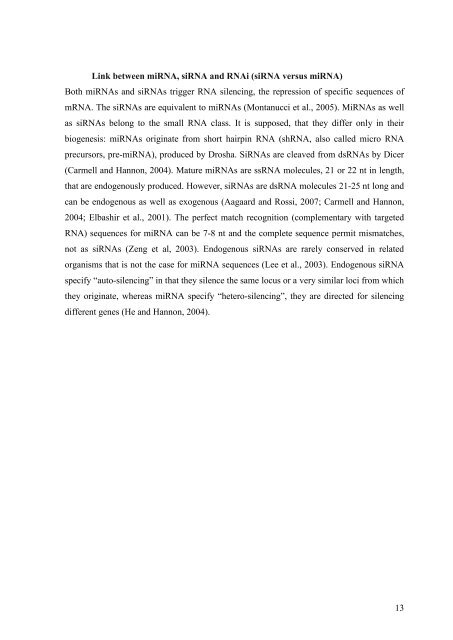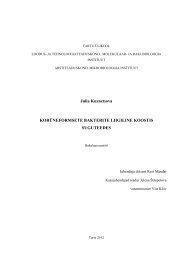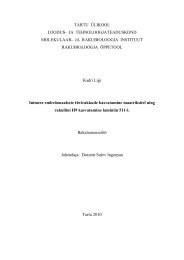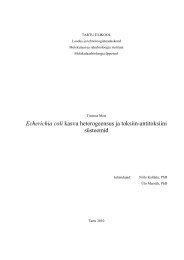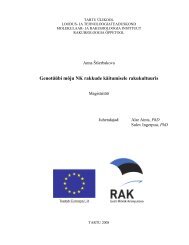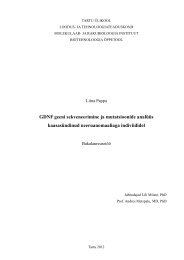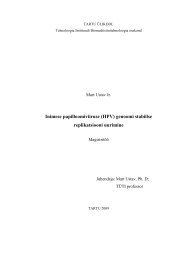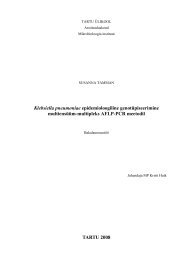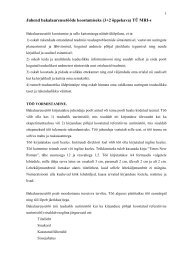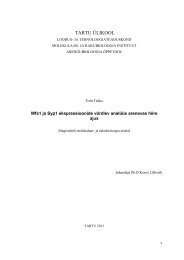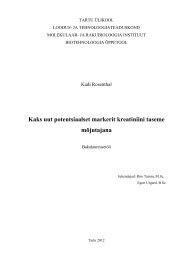Viruses and RNA interference in mammalian cells
Viruses and RNA interference in mammalian cells
Viruses and RNA interference in mammalian cells
You also want an ePaper? Increase the reach of your titles
YUMPU automatically turns print PDFs into web optimized ePapers that Google loves.
L<strong>in</strong>k between mi<strong>RNA</strong>, si<strong>RNA</strong> <strong>and</strong> <strong>RNA</strong>i (si<strong>RNA</strong> versus mi<strong>RNA</strong>)<br />
Both mi<strong>RNA</strong>s <strong>and</strong> si<strong>RNA</strong>s trigger <strong>RNA</strong> silenc<strong>in</strong>g, the repression of specific sequences of<br />
m<strong>RNA</strong>. The si<strong>RNA</strong>s are equivalent to mi<strong>RNA</strong>s (Montanucci et al., 2005). Mi<strong>RNA</strong>s as well<br />
as si<strong>RNA</strong>s belong to the small <strong>RNA</strong> class. It is supposed, that they differ only <strong>in</strong> their<br />
biogenesis: mi<strong>RNA</strong>s orig<strong>in</strong>ate from short hairp<strong>in</strong> <strong>RNA</strong> (sh<strong>RNA</strong>, also called micro <strong>RNA</strong><br />
precursors, pre-mi<strong>RNA</strong>), produced by Drosha. Si<strong>RNA</strong>s are cleaved from ds<strong>RNA</strong>s by Dicer<br />
(Carmell <strong>and</strong> Hannon, 2004). Mature mi<strong>RNA</strong>s are ss<strong>RNA</strong> molecules, 21 or 22 nt <strong>in</strong> length,<br />
that are endogenously produced. However, si<strong>RNA</strong>s are ds<strong>RNA</strong> molecules 21-25 nt long <strong>and</strong><br />
can be endogenous as well as exogenous (Aagaard <strong>and</strong> Rossi, 2007; Carmell <strong>and</strong> Hannon,<br />
2004; Elbashir et al., 2001). The perfect match recognition (complementary with targeted<br />
<strong>RNA</strong>) sequences for mi<strong>RNA</strong> can be 7-8 nt <strong>and</strong> the complete sequence permit mismatches,<br />
not as si<strong>RNA</strong>s (Zeng et al, 2003). Endogenous si<strong>RNA</strong>s are rarely conserved <strong>in</strong> related<br />
organisms that is not the case for mi<strong>RNA</strong> sequences (Lee et al., 2003). Endogenous si<strong>RNA</strong><br />
specify “auto-silenc<strong>in</strong>g” <strong>in</strong> that they silence the same locus or a very similar loci from which<br />
they orig<strong>in</strong>ate, whereas mi<strong>RNA</strong> specify “hetero-silenc<strong>in</strong>g”, they are directed for silenc<strong>in</strong>g<br />
different genes (He <strong>and</strong> Hannon, 2004).<br />
13


